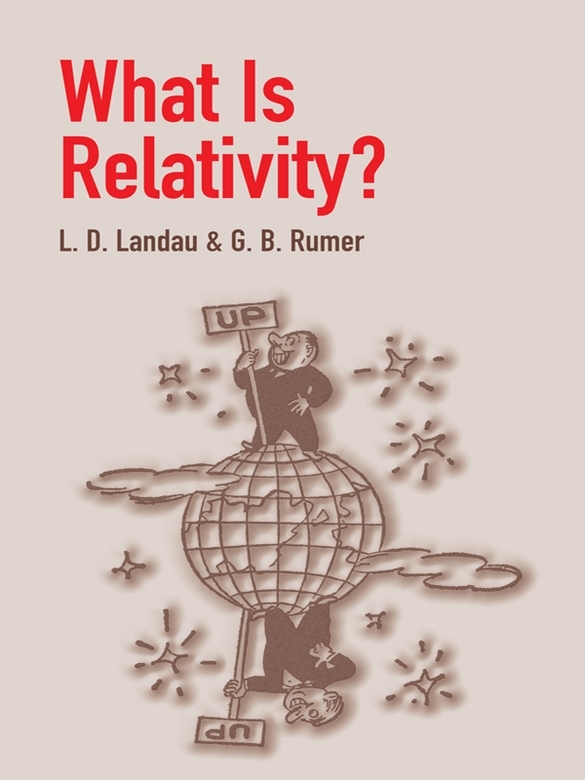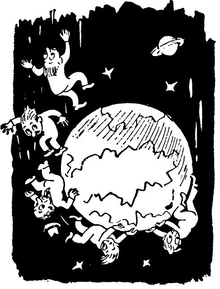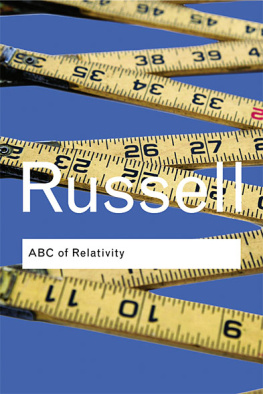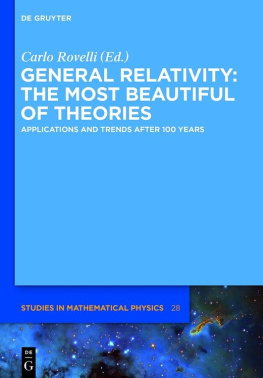Landau L. D. - What Is Relativity?
Here you can read online Landau L. D. - What Is Relativity? full text of the book (entire story) in english for free. Download pdf and epub, get meaning, cover and reviews about this ebook. year: 2012, publisher: Dover Publications, genre: Children. Description of the work, (preface) as well as reviews are available. Best literature library LitArk.com created for fans of good reading and offers a wide selection of genres:
Romance novel
Science fiction
Adventure
Detective
Science
History
Home and family
Prose
Art
Politics
Computer
Non-fiction
Religion
Business
Children
Humor
Choose a favorite category and find really read worthwhile books. Enjoy immersion in the world of imagination, feel the emotions of the characters or learn something new for yourself, make an fascinating discovery.
- Book:What Is Relativity?
- Author:
- Publisher:Dover Publications
- Genre:
- Year:2012
- Rating:4 / 5
- Favourites:Add to favourites
- Your mark:
- 80
- 1
- 2
- 3
- 4
- 5
What Is Relativity?: summary, description and annotation
We offer to read an annotation, description, summary or preface (depends on what the author of the book "What Is Relativity?" wrote himself). If you haven't found the necessary information about the book — write in the comments, we will try to find it.
What Is Relativity? — read online for free the complete book (whole text) full work
Below is the text of the book, divided by pages. System saving the place of the last page read, allows you to conveniently read the book "What Is Relativity?" online for free, without having to search again every time where you left off. Put a bookmark, and you can go to the page where you finished reading at any time.
Font size:
Interval:
Bookmark:

We have seen that rigorous and convincing experiments force us to accept the truth of the theory of relativity, which reveals some of the amazing properties of the world around usproperties that escape us in initial (or, to be more precise, superficial) study.
We have seen what deep, radical changes the theory of relativity has wrought in some of mans basic notions and ideas. Does this not signify the complete collapse of the old, familiar ideas? Does it mean that the whole of the physics in existence before the emergence of the principle of relativity should be scrapped and thrown away, like an old boot that has served its useful time but is no longer of use to anybody?
If that were so, it would be futile to pursue scientific investigation. We would never be sure that in the future a new doctrine might not turn up, completely overthrowing everything that had gone before.
Let us imagine a passenger traveling in an ordinary train who decided to introduce corrections for relativity, fearing that otherwise his watch would be slow compared to the station clock. We would laugh at such a passenger. For the realistic correction would amount to only an infinitesimal part of a secondfar less than the effect of a single jerk in the motion of the train upon his watch.
A chemical engineer who doubted whether the quantity of water he was heating retained a constant mass would need to have his head examined. But a physicist who failed to take into account the change of mass in nuclear transmutations would be sacked for incompetence.
Engineers will continue to plan their machines on the basis of the laws of classical physics, because the corrections for the theory of relativity have a much smaller influence on their engines than a single microbe settling on a flywheel. But a physicist observing fast electrons must certainly take into account the change of the mass of the electrons as they accelerate.
Thus the theory of relativity does not contradict but only deepens the ideas and concepts created in older science. It determines the limits within which these older ideas can be applied without leading to incorrect results. None of the laws of nature discovered by physicists before the birth of the theory of relativity are changed, but the limits of their application are now clearly marked out.
The relationship between the physics that takes into account the theory of relativitywhich is called relativistic physicsand the older physicswhich is called classicalis comparable to that between higher geodesy, which takes into account the spherical shape of the Earth, and lower geodesy, which neglects the spherical shape. Higher geodesy must start out from the relativity of the concept of the vertical; relativistic physics must take into account the relativity of the dimensions of a body and of time intervals between two events. Just as higher geodesy is a development of lower geodesy, so is relativistic physics a development and widening of classical physics.
We can perform the transition from the formulae of spherical geometrythe geometry on the surface of a sphereto the formulae of plane geometry if we assume that the radius of the Earth is infinitely large. Then the Earth is no longer taken to be a sphere but an infinite plane; the vertical assumes an absolute meaning, and the sum of the angles of a triangle proves to be exactly two right angles.
Similarly, we can make a transition from relativistic to classical physics by assuming that the speed of light is infinitely large i.e. , that light spreads instantaneously. If light spreads instantaneously, then, as we have seen, the notion of simultaneous events becomes absolute. Time intervals between events and sizes of objects acquire an absolute meaning, without reference to the laboratories from which they are observed. In this way all classical concepts can be preserved. And in our ordinary affairs, we can take the speed of light to be infinite, for all practical purposes.
However, any attempt to reconcile the actually finite speed of light with the old notions of space and time would put us in the position of the person who knows that the Earth is a sphere but is certain that the vertical in his native city is the absolute vertical and who therefore is afraid of moving far from his home for fear of falling head over heels into empty space.

Evidently not. Even if you choose perfectly sensible words and put them together according to all the rules of grammar, you may still get complete nonsense. For instance the statement This water is triangular can hardly be given any meaning.
Unfortunately, however, not all examples of nonsense are so obvious and it often happens that a statement appears perfectly sensible at first sight but proves to be absurd on closer examination.
Look at the drawing on the next page. On which side of the road is the houseon the right or on the left? It is impossible to answer this question directly.
If you are walking from the bridge to the wood, the house will be on the left-hand side, but if you go from the wood to the bridge, you find the house on the right. Clearly, to speak of the right- or left-hand side of the road you must take into account the direction relative to which right or left is indicated.
It does make sense to speak of the right bank of a river, but only because the current determines the direction of the river. Likewise we can only say that cars keep to the right because the movement of a car singles out one of the two possible directions along the road.
We see that the notions right and left are relative: They acquire meaning only after the direction relative to which they are defined has been indicated.

The answer depends on where the question is being asked. When it is daytime in Moscow it is night in Vladivostok. There is no contradiction in this. The simple fact is that day and night are relative notions and our question cannot be answered without indicating the point on the globe relative to which the question is being asked.
In the first drawing on the opposite page, the shepherd is obviously bigger than the cow; in the second the cow is bigger than the shepherd. Again there is no contradiction. The reason is that the two drawings have been made by people observing from different points: One of them stood closer to the cow, the other closer to the shepherd. The picture is determined not by the actual sizes of the objects but by the angles at which they are seen. Evidently such angular dimensions of objects are relative. It makes no sense to speak of the angular dimensions of objects without indicating the point in space from which they are observed. For instance, to say, This tower is seen under an angle of 45, is to say precisely nothing. But the statement that the tower is seen under an angle of 45 from a point 15 meters (about 50 feet) away has a definite meaning; from this you can conclude that the tower is 15 meters high.
Font size:
Interval:
Bookmark:
Similar books «What Is Relativity?»
Look at similar books to What Is Relativity?. We have selected literature similar in name and meaning in the hope of providing readers with more options to find new, interesting, not yet read works.
Discussion, reviews of the book What Is Relativity? and just readers' own opinions. Leave your comments, write what you think about the work, its meaning or the main characters. Specify what exactly you liked and what you didn't like, and why you think so.













